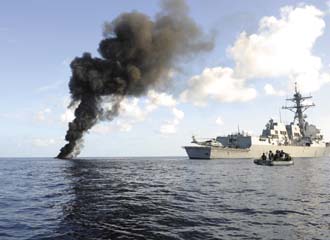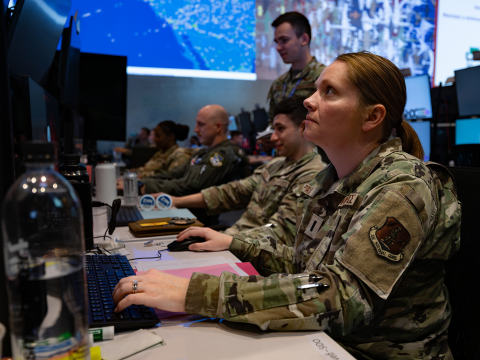Piracy Threatens Global Economy
 |
The Arleigh Burke-class guided missile destroyer USS Farragut disables a suspected pirate skiff. The ship is part of Combined Task Force 151, which conducts anti-piracy operations in the Gulf of Aden. |
The attire may be different and the swashbuckling kept to a minimum, but for today’s pirates the aim is the same as in centuries past: loot and lawlessness. Piracy is a lucrative alternative for starving people who live in regions with no civil authority to provide economic or political stability. As a result, the populace in countries surrounding the Gulf of Aden—particularly Somalia—are turning to barons of corruption who now have a multitude of impressionable young men willing to fight extraordinary odds even to their deaths. Unfortunately, the solution to this problem is as complex as the cause.
Between 2008 and 2009, acts of piracy grew by 96 percent. During the first week of 2010, pirates successfully captured four ships, and a record in ransom was paid—between $5.5 million and $9 million—for the release of a crude oil tanker. At one point in early February 2010, 11 ships with approximately 270 people aboard were being held hostage.
Pirates take ships hostage for one simple reason: ransom. While the cargo may be worth millions of dollars, transporting and selling it involves unnecessary logistics when the entire ship and crew can be ransomed easily. The amounts and number of individual ransom payments that companies currently fork over are sketchy at best; however, experts estimate that they are certainly always in the millions of dollars.
Corporations now have become so accustomed to piracy that they simply accept ransom payments as the price of doing business, a practice that exacerbates the problem: The more cash companies are willing to pay regularly, the more lucrative piracy as a business becomes. In addition, insurance costs have skyrocketed to the point that companies would rather take a chance sailing through pirate-ridden waters and pay ransoms than repeatedly pay monumental premiums.
According to Dr. Virginia Lunsford, associate professor, U.S. Naval Academy,
The pirate attacks of today actually began quite innocuously many years ago as an attempt to protect an economic way of life, she explains. The waters off the Somali coastline were teeming with fish, and the citizens used this natural resource to survive. However, anglers from other countries soon caught on to the financial prospects of the region, moved in and worked the waters using sophisticated equipment, reducing the number of fish significantly. To add insult to injury, some countries looked at the Somali coastal waters as a dumping ground for toxic chemicals that polluted the waters and killed the fish, Lunsford explains.
To fight for their economic survival, Somalis began boarding ships that were operating illegally off their coastline. However, once they and the region’s warlords discovered the fruitfulness of ransoming commercial ships, defensive actions turned into lucrative opportunities and the “business” grew, she relates. Now, the challenge of solving a problem off the coastline of one country has gone global. International corporations have blossomed and shipping continues to be 90 percent of how goods are transported.
Despite its current global reach, many still view piracy as a problem of the 17th and 18th centuries, not pervasive or life-threatening enough to warrant much attention. But, public interest in piracy was piqued in April 2009 with the capture of the M/V Maersk-Alabama, an event that made headlines worldwide. The
In the public eye or not,
The ambiguous nature of national governments’ responsibility to ensure safety on the high seas complicates how the
Many believe that the U.N.’s resolutions that enable countries to intervene in acts of piracy are sufficient. On the other hand, suspicious ships cannot be detained and boarded merely because they appear threatening. While this approach certainly holds up free nations’ sense of justice, pirates are more likely to exploit rather than acquiesce to it.
 |
The M/V Maersk-Alabama’s lifeboat—in which pirates held Captain Richard Phillips hostage for five days in April 2009—is hoisted aboard the USS Boxer. The attempt to hijack the ship off the Somali coast failed, and actions taken by U.S. Navy SEALs ensured the safe release of the captain. |
The colonel believes that a proactive stance could prevent such incidents. “Aren’t we [the U.S. Navy and
The colonel believes that it will take some significant event to prompt the
“I don’t know what that threshold is, but I think any loss-of-life threshold would get your interest. The other incident that would raise interest is a drawn-out episode with a ship that is carrying tanks and arms. There have been hazardous cargo issues. So I think if it crosses into a broader security issue, depending on what kind of cargo ends up in those pirates’ moorings, it seems to increase attention. The last threshold I don’t think we’ve crossed yet is what I would categorize as a catastrophic event, and that would be the oil tanker or hazardous cargo attack that results in a hole in the side of a ship and a spill running into ground,” the colonel says.
This is not to say that efforts of the Combined Maritime Forces, European Union and NATO have been useless. Slowly and consistently, their presence and security activities near coastlines have driven pirates farther out to sea. For example, in the past, spring’s calm weather in the region increased the number of attacks. However, early this spring, pirate actions groups, which include a mother ship and several attack skiffs, unsuccessfully attempted to attack 12 ships and successfully took hostage three ships. The difference is that rather than hugging a coastline, these groups were operating in an ocean area nearly the size of
The colonel is not naïve about the complexity of the international problems that both instigate piracy and make it so difficult to prevent. In this regard, he notes that discussions and agreement on an international level have not been enough to determine how to approach the assortment of problems.
For example, while piracy is a symptom of
From a military perspective, the colonel notes that at one time, the Navy and Marines had the capability and the authority to board suspicious ships; however, the
But decisiveness is just one element of the enormity of the problem. The sheer size of the region that must be policed is an immense challenge. The number of
To augment this effort, the
As the piracy attack area grows, the military will continue to count on technology to keep watch over the seas. Although ISR capabilities are useful, additional technical requirements continually need to be met, Col. Coffman says. Any technologies that contribute to maritime surveillance and tracking of commercial vehicles would be extremely helpful, and opportunities abound in this field, he maintains. ISR unmanned aerial system platforms could accomplish this task, but they must be equipped with command, control, communications and computer capabilities. In addition, without sufficient bandwidth, ISR-gathered data such as video cannot be transmitted fast enough to respond before a target moves. Without interoperability, coordinated attacks would be nearly impossible.
Even with these advanced technical advantages, however, the colonel maintains that dealing with piracy is difficult on a
The colonel does not dismiss the benefits of collaborating with other countries in the area. In fact, the
But the problem of curbing piracy does not end when pirates are caught. In fact, Lunsford explains that the authorities who detain these criminals have options about where to take them for trial, so they must determine their own policy. In the case of the United States, for example, the question becomes whether they should be taken to Somalia, where no official court system exists; to a nearby country such as Kenya, which has taken not only pirates but also Somali refugees; or brought back to the United States where they would be afforded the same rights as a citizen, including the presumption of innocence. The last time a piracy trial was conducted in the
WEB RESOURCES
13th Marine Expeditionary Unit: www.i-mef.usmc.mil/external/13thmeu
Commander, U.S. Naval Forces Central Command: www.cusnc.navy.mil
ICC Commercial Crime Services: www.icc-ccs.org



Comments